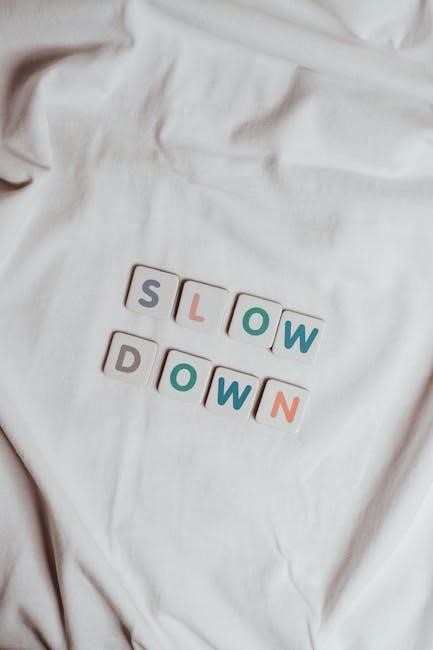Sight words are essential for building reading fluency, as they are high-frequency words recognized by sight rather than sounded out, aiding in effortless reading comprehension and speed.
1.1 What Are Sight Words?
Sight words are high-frequency words that appear regularly in texts and are recognized by sight rather than decoded; They often don’t follow phonetic rules, making memorization essential. Examples include “the,” “and,” and “is.” These words are foundational for reading fluency, as they enable quick and effortless recognition, allowing readers to focus on comprehension and meaning in sentences.
1.2 Importance of Sight Words in Reading Fluency
Sight words are critical for reading fluency as they enable quick recognition, reducing the need to decode. This allows readers to focus on comprehension and rhythm, making reading smoother and more efficient. Mastering sight words builds confidence and enhances overall reading skills, as they form the foundation of many texts and sentences.

Benefits of Using Sight Word Sentences
Sight word sentences improve reading fluency, confidence, and comprehension by providing context for high-frequency words, making learning engaging and effective for young readers.
2.1 Enhancing Reading Confidence
Sight word sentences help students recognize high-frequency words effortlessly, allowing them to read with accuracy and fluency. This builds confidence as they experience success in reading and understanding texts, fostering a positive attitude toward literacy and learning.
2.2 Building Fluency and Speed
Sight word sentences enhance reading fluency by familiarizing students with high-frequency words, enabling them to read smoothly without decoding. Regular practice with these sentences improves speed and accuracy, fostering automaticity and confidence, which are crucial for advanced reading skills and overall literacy development.
2.3 Improving Comprehension Skills
Sight word sentences play a vital role in enhancing comprehension by embedding high-frequency words in meaningful contexts. This approach allows students to focus on understanding the overall message rather than decoding individual words, thereby improving their ability to interpret and grasp the content effectively.
Easy Sight Word Sentences for Kindergarten
Easy sight word sentences are designed for young learners, featuring simple structures and high-frequency words to build foundational reading skills, fluency, and confidence in early literacy.
3.1 Simple and Engaging Sentence Structures
Simple and engaging sentence structures are designed to help young learners recognize high-frequency sight words in context. These sentences use predictable patterns and repetition, making them easy for kindergarten students to read and understand. By focusing on common sight words, they build foundational reading skills and confidence, fostering a love for early literacy.
3.2 Focus on High-Frequency Words
High-frequency words, such as “the,” “and,” and “is,” are prioritized in easy sight word sentences. These words appear frequently in texts but often don’t follow phonetic rules, making them essential for recognition. By practicing these words in simple sentences, students develop fluency and build a strong foundation for reading success and comprehension.
3.3 Printable PDF Resources for Kindergarten
Printable PDF resources for kindergarten offer engaging sight word sentences designed to make learning fun and accessible. These resources feature simple sentences, predictable structures, and visual aids, helping young learners recognize and read high-frequency words with ease. They are ideal for classroom or home use, providing a solid foundation for early literacy skills and reading confidence.

Sight Word Sentences for Different Grade Levels
Sight word sentences are tailored for various grade levels, ensuring age-appropriate learning. From kindergarten to higher grades, these resources adapt to meet the developmental needs of students, fostering reading growth and fluency through targeted practice.
4.1 First Grade Sight Word Sentences
First-grade sight word sentences are designed to reinforce high-frequency words, such as those from Dolch and Fry’s lists. These sentences use simple structures and visual aids to engage young learners, helping them build fluency and confidence. Interactive activities like fill-in-the-blank and cut-and-paste exercises make learning fun and effective, with downloadable PDFs available for easy practice at home or in the classroom.
4.2 Second Grade Sight Word Sentences
Second-grade sight word sentences expand on foundational skills, introducing more complex high-frequency words. These sentences are structured to enhance reading fluency and comprehension, often incorporating visual supports and interactive elements. Printable PDFs and digital tools provide engaging ways for students to practice, reinforcing sight word mastery through repetition and context-based learning.
4.3 Customizing Sentences for Various Learning Levels
Customizing sight word sentences allows educators to tailor activities to different learning levels, ensuring each student’s needs are met. By adjusting sentence complexity and incorporating visual aids, teachers can create engaging exercises that cater to advanced, average, and struggling learners, providing a personalized approach to sight word mastery and reading fluency development.

Interactive Activities with Sight Word Sentences
Engage students with fill-in-the-blank worksheets, cut-and-paste sentence building, and sight word games. These activities make learning interactive and fun, reinforcing sight word recognition and fluency through hands-on practice.
5.1 Fill-in-the-Blank Worksheets
Fill-in-the-blank worksheets are a popular activity for practicing sight words. They provide structured sentences with missing words, allowing students to fill in the gaps using their sight word knowledge. These worksheets reinforce recognition, writing, and reading skills. Many resources, like the Marie Fry First 100 Sight Words Fill-in-the-Blank Sentences, offer 22 worksheets with 5-6 blanks each, focusing on high-frequency words and their correct usage in context.
5.2 Cut-and-Paste Sentence Building
Cut-and-paste activities are an engaging way to practice sight words by building complete sentences. Students cut out word cards and arrange them to form meaningful sentences, enhancing their understanding of word recognition and sentence structure. These exercises are particularly effective for young learners, as they combine tactile learning with reading practice, improving fluency and confidence in sight word usage.
5.3 Sight Word Games and Flashcards
Sight word games and flashcards are interactive tools that make learning fun and engaging. Flashcards help students quickly recognize high-frequency words, while games like memory matching or bingo reinforce sight word mastery. These activities provide repetitive practice, essential for building confidence and fluency in reading. Digital flashcard apps also offer a modern, convenient way to practice anytime, anywhere.

The Role of Visual Aids in Sight Word Sentences
Visual aids enhance sight word learning by providing context and supporting word recognition. Pictures help students connect words to meanings, making sentences more relatable and easier to understand, especially for young learners.
6.1 Using Pictures to Support Reading
Pictures enhance sight word sentences by providing visual context, making them relatable and easier to understand. Images help students connect words to meanings, improving comprehension and memory. This combination of text and visuals creates an engaging and interactive learning experience, particularly benefiting early readers and those with visual learning styles.
6.2 Combining Words and Images for Better Understanding
Integrating images with sight word sentences enhances understanding by offering visual cues, aiding in word recognition and retention. This dual approach supports early readers in grasping sentence structure and context, making learning more effective and enjoyable. The combination fosters a deeper connection between words and their meanings, promoting literacy skills and confidence.
Fluency Practice with Sight Word Sentences
Fluency practice with sight word sentences involves repetition and consistency, helping readers build speed and accuracy. Regular exercises ensure smooth transitions between words, enhancing overall reading proficiency.
7.1 Repetition and Consistency in Practice
Repetition and consistency are key to mastering sight word sentences. Regular practice with easy PDF resources ensures familiarity, building fluency and confidence in young readers. Daily exercises reinforce recognition, making reading smoother and more natural over time.
7.2 Timed Reading Exercises
Timed reading exercises with easy sight word sentences PDFs help measure progress and boost reading speed. Regular timing builds fluency, encouraging students to read accurately and confidently. These exercises are effective tools for tracking improvement and developing a smooth reading rhythm.
7.3 Progress Monitoring Tools
Progress monitoring tools, such as worksheets and digital trackers, help assess sight word mastery. Easy sight word sentences PDFs provide measurable goals, allowing teachers to track fluency and accuracy. Regular assessments ensure tailored instruction, identifying gaps and reinforcing learning effectively to support continuous improvement in reading skills.

Assessing Sight Word Mastery
Assessing sight word mastery involves regular evaluations of recognition, fluency, and application. Tools like worksheets, flashcards, and reading exercises help track progress, ensuring learners grasp and retain high-frequency words effectively through consistent practice and repetition.
8.1 Strategies for Measuring Progress
Regular assessments, such as timed readings and fill-in-the-blank exercises, help measure sight word mastery. Tracking accuracy and fluency over time reveals progress, while identifying gaps ensures targeted practice. Using tools like flashcards and worksheets provides concrete data to monitor improvement and adjust instruction, fostering confidence and competence in sight word recognition and application.
8.2 Identifying and Addressing Gaps
Use assessments like flashcards and worksheets to pinpoint sight word challenges. For struggling students, provide targeted practice with interactive activities and one-on-one support. Regularly review progress to address gaps, ensuring mastery before moving forward. This focused approach helps build confidence and strengthens foundational reading skills, fostering long-term sight word proficiency and overall literacy development.
Free PDF Resources for Sight Word Sentences
Discover free sight word sentences PDFs designed for kindergarten and early learners. These resources, available on websites like eduflakes.com, offer engaging worksheets and activities to practice high-frequency words effectively at home or in the classroom, making learning fun and accessible for young students.
9.1 Popular Websites Offering Free Downloads
Websites like eduflakes.com and aspoonfuloflearning.com offer free sight word sentences PDFs. These platforms provide a variety of printable worksheets, activity sheets, and sight word phrases for kindergarten and early learners. They are trusted resources for teachers and parents seeking engaging and educational materials to support reading development.
9.2 Printable Worksheets and Activity Sheets
Printable worksheets and activity sheets are designed to engage young learners with sight word sentences. They include fill-in-the-blank exercises, cut-and-paste activities, and sight word cards. These resources often feature simple sentences, predictable structures, and visual aids, making learning fun and effective. Websites like eduflakes.com offer free, downloadable PDFs tailored for kindergarten and early literacy development.

Tips for Printing and Using Sight Word PDFs
Print sight word PDFs on sturdy paper or cardstock for durability. Organize worksheets in folders or binders for easy access and regular practice, ensuring effective learning outcomes.
10.1 Choosing the Right Paper and Print Settings
Select high-quality paper or cardstock for durability. Use standard print settings with clear DPI for readability. Ensure proper page alignment to avoid cutoff text. Consider color printing for engagement. Adjust margins for optimal spacing. Laminate sheets for longevity. These choices ensure your sight word PDFs are visually appealing, functional, and long-lasting for effective learning experiences.
10.2 Organizing Worksheets for Effective Use
Organize worksheets in labeled binders or folders for easy access. Use dividers to categorize by grade or difficulty level. Store them in a designated area, ensuring both teachers and students can locate materials quickly. Consider creating a master list or index for tracking specific sight word PDFs. Proper organization enhances lesson planning and ensures resources remain tidy and usable over time.

Integrating Technology with Sight Word PDFs
Utilize digital tools to enhance sight word learning. Convert PDFs into interactive formats using educational apps or platforms. Digital flashcards and games can make practice engaging and accessible for all learners.
11.1 Digital Tools for Interactive Learning
Digital tools like educational apps and online platforms offer interactive ways to practice sight words. Apps such as ABCmouse and Starfall provide engaging games and activities. Interactive PDFs can be enhanced with clickable flashcards or audio features. These tools make learning dynamic and accessible, allowing students to practice anytime, anywhere, while tracking progress for personalized learning experiences.
11.2 Apps and Software for Sight Word Practice
Apps like ABCmouse and Starfall offer interactive sight word games and flashcards. Software such as Reading Bear provides video lessons. These tools feature progress tracking, audio support, and offline access. They support personalized learning, making practice engaging and effective for students to master sight words at their own pace.

Involving Parents in Sight Word Learning
Parents can support sight word practice through homework activities and consistent reinforcement. Tips include reading together, using flashcards, and discussing progress to foster a strong learning environment at home.
12.1 Homework Activities and Exercises
Parents can reinforce sight word learning with simple exercises like reading sight word sentences together or using flashcards. Printable PDF worksheets with fill-in-the-blank activities provide structured practice, ensuring consistent progress and engagement at home.
12.2 Tips for Parents to Reinforce Learning
Parents can create a supportive environment by reading together daily, using flashcards, and incorporating sight word games. Encouraging children to read aloud from PDF resources and providing positive feedback fosters confidence and reinforces their sight word skills effectively.
Incorporating easy sight word sentences and PDF resources fosters reading fluency and confidence. Consistent practice with these tools ensures steady progress, helping learners master essential sight words effectively.
13.1 Summarizing the Benefits of Sight Word Sentences
Sight word sentences offer numerous benefits, enhancing reading fluency, confidence, and comprehension. They provide context for high-frequency words, aiding recognition and retention. By integrating sight words into meaningful sentences, learners develop essential reading skills. These resources make practice engaging and effective, supporting overall literacy development and preparing students for more complex texts.
13.2 Encouraging Continuous Practice and Improvement
Consistent practice with sight word sentences is crucial for mastery. Regular repetition reinforces recognition and fluency, while interactive activities keep learning engaging. Parents and educators should encourage daily practice, celebrate progress, and adapt methods to meet individual needs, fostering a lifelong love for reading and continuous improvement in literacy skills.




About the author